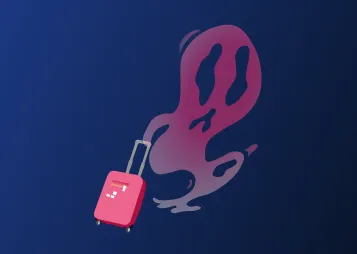None of us are safe….
Customer ghosting doesn’t just happen in the sales process.
CS are just as at risk of having a client go quiet on them.
And when it happens, it hurts.
When a client leaves, it means so much more than the monetary value of the lost renewal or revenue. It signifies a loss of faith in your product or service, a lack of understanding of what you bring to the market and a disenchantment with your vision.
As we know, word spreads quickly, so this loss can quickly be amplified across your market.
While you may never want a client to leave you, the least you want is for them to leave explaining their reasoning. Passive churn or customer ghosting is a real threat that CSMs need to face head-on, as in this market every client matters.
Customer churn is on the rise across industries and CSMs are left desperately looking for answers (Google searches are up 16% in the last 12 months, so you’re not alone).
There’s a lot to unpack with churn, so let’s focus in on those silent churners today.
Recognizing pre-ghosting behaviour signals
Preventing ghosting in CS starts with recognizing the signals that it might be about to happen.
So what are the signs?
#1 Lower usage
Likely your first warning sign. Log-ins slow down, time in app reduces (below natural seasonality) and feature adoption trickles to a stop. Actions speak louder than words so don’t ignore this behavior, particularly for your key users and champions.
#2 CS requests
Has your contact been emailing less? Or at all? Are they actively seeking your advice and insight into the account or do they seem to be ‘just getting on with things themselves’? If a client is entirely self-serving - even if they have done so from day one - you should wonder why they are not engaging with you as their CSM.
#3 Engagement in CS meetings
Before the meeting, note whether they proposed the meeting or you did. During the meeting recognize how engaged they seem, how many questions they ask and how many of your contacts attend. After the meeting, note whether they have any actions they are carrying out and how committed they appear to them.
#4 Support requests & NPS
Check-in on users’ support tickets, look at both what is being asked and how it is being asked as this will reveal a lot about the user’s sentiment. If you can’t get anything from this, your NPS scores won’t lie, so keep on top of these.
Determining the root cause of customer dissatisfaction
Just like any pesky symptom you try your best to ignore, it’s not actually the root cause of the problem. These pre-ghosting signals aren’t the issue. There is an underlying cause.
It’s your job to diagnose that issue with care and precision, working with your client to determine how you can solve it.
Let’s get diagnosing.
First off, is the root dissatisfaction active or passive? In other words, do they actively dislike your product or is there just a certain level of indifference towards it? Their dissatisfaction being active or passive will dictate your process.
Active dissatisfaction suggests issues like not seeing the results they expected, frustrations with usability or adoption, or use of the product taking up too much of their time or their team’s time. Chances are, your product hasn’t made them look as good in their role as they had hoped, and they’re angry about it.
For each of these root issues, there are relevant actions you need to take. It might be passing feedback to your dev team to improve functionality or create nuanced customizations for them. Help your devs understand where clients lose time and work together to come up with helpful solutions.
Alternatively, it might be that a training session is needed for their users to better understand how to use your tool effectively. Or potentially, that you need to be more hands-on as a CSM to achieve their success with the product.
Passive dissatisfaction is all about indifference due to the perceived value of your product.
“It’s ok, it kind of does what I need it to”
“It's not what I expected but we’ll use it for now”
“Oh that thing? We signed up for a year so it just sort of sits there”
This calls for an exercise in communication, led by you.
You need to communicate clearly and succinctly the true value of your product (and CS service), highly relevant to them as a customer. Paint the big picture of where using your product will get them. Sell the dream in a way that is achievable and with realistic steps towards it. Make clear, tangible promises and prepare to over-deliver.
Both active and passive dissatisfaction diagnoses require the client to be honest and open with you. So, what if they shut you down with the classic “it’s just too expensive for what it is”?
Take this as your reminder.
Print out this page and pin it to your office wall.
Better yet - scribble this on a post-it note and stick it on your bathroom mirror.
(Making it a morning mantra is entirely optional)
Cost is never the issue.
If your client is saying they will not be renewing because of cost, they do not perceive your value.
Return to the communication exercise of passive dissatisfaction above. This client once saw your value and believed in it enough to sign a contract with you, to achieve their goals in collaboration with you as a valued partner.
Somewhere along the line, you lost their faith. You need to fight to bring the vision back with a highly bespoke and resonant value proposition. This is what customer success is all about. So get fighting for it, CS soldier.
Bolstering the relationship outside of CS
Once the diagnosing is done, you can step out of your doctor’s uniform and get back to what you love - some good old-fashioned relationship-building. Build and bolster your relationship with your key contacts, outside of your client/CSM interactions.
Get connected on LinkedIn, comment, share and engage in their news and celebrations. A little goes a long way here, and it’s never a bad thing to have your name out there too.
Gift with intent. I’m not talking about a quick, thoughtless freebie of your branded merch. Find out their favorite wine, or send cakes on a career milestone or anniversary. Add a personal touch and gift memorably.
Attending events means a lot, so if your clients operate nearby, make sure you are present for the events they hold. Network within their organization to show your face and your value outside of your primary contacts.
And finally…
I hope I’ve made it clear now how crucial it is to communicate your value as a CSM. But for a little extra explanation, I wanted to share these wise words of Angie Judge from Dexibit.
Her post epitomizes what clients both require and deserve from their CSM.
Another one to print out and stick to your mirror, if you’re building your collection.
Want to tackle ghosting? Try some bulletproof communication boundaries.
Giuliana Kiabi (née Ruocco) is the Enterprise Client Success Manager at Jiminny. Recognized as an Elites CSM Awards Finalist in 2023 for her dedication to Customer Success, Giuliana’s background in property, events and SaaS has primed her for helping clients find solutions, designing and implementing sustainable processes to foster long-term success.





.webp)






